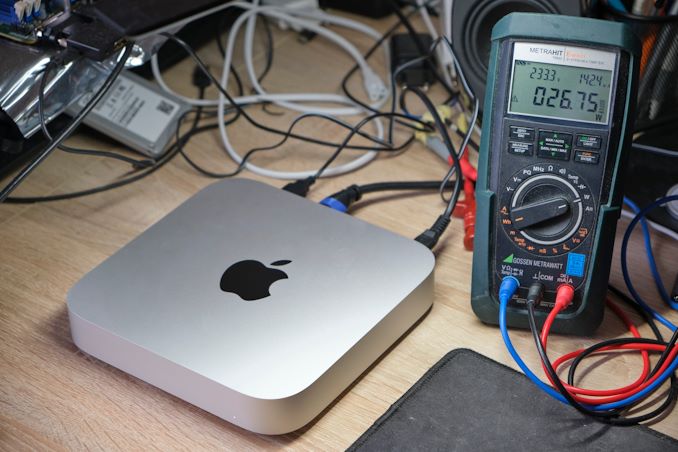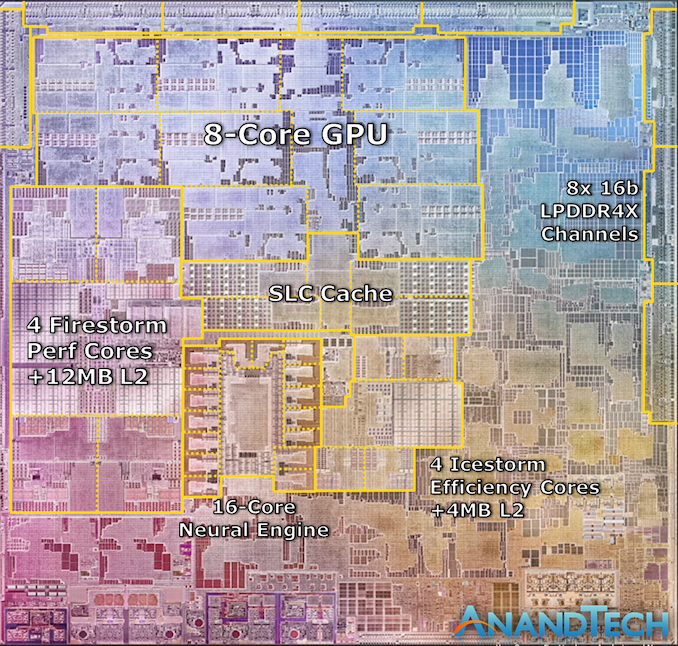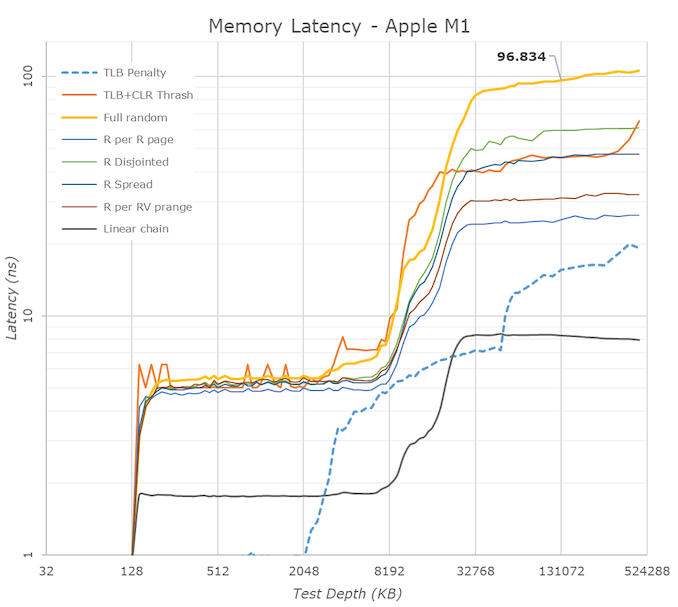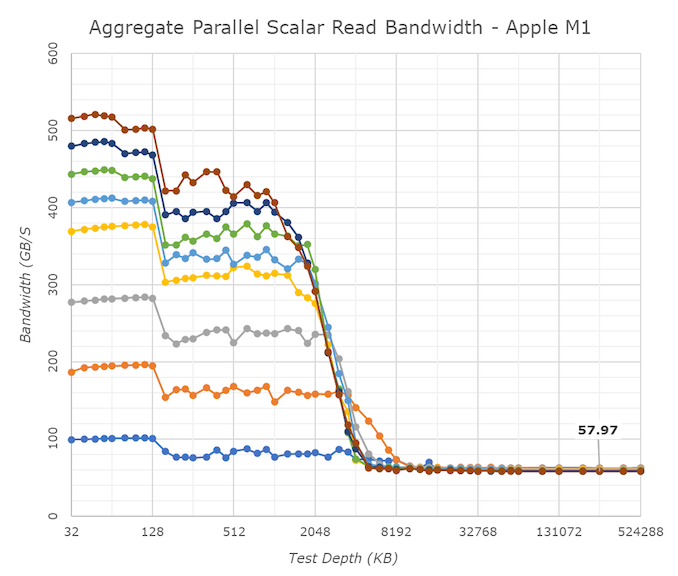The 2020 Mac Mini Unleashed: Putting Apple Silicon M1 To The Test
by Andrei Frumusanu on November 17, 2020 9:00 AM EST
Last week, Apple made industry news by announcing new Mac products based upon the company’s new Apple Silicon M1 SoC chip, marking the first move of a planned 2-year roadmap to transition over from Intel-based x86 CPUs to the company’s own in-house designed microprocessors running on the Arm instruction set.
During the launch we had prepared an extensive article based on the company’s already related Apple A14 chip, found in the new generation iPhone 12 phones. This includes a rather extensive microarchitectural deep-dive into Apple’s new Firestorm cores which power both the A14 as well as the new Apple Silicon M1, I would recommend a read if you haven’t had the opportunity yet:
Since a few days, we’ve been able to get our hands on one of the first Apple Silicon M1 devices: the new Mac mini 2020 edition. While in our analysis article last week we had based our numbers on the A14, this time around we’ve measured the real performance on the actual new higher-power design. We haven’t had much time, but we’ll be bringing you the key datapoints relevant to the new Apple Silicon M1.
Apple Silicon M1: Firestorm cores at 3.2GHz & ~20-24W TDP?
During the launch event, one thing that was in Apple fashion typically missing from the presentation were actual details on the clock frequencies of the design, as well as its TDP which it can sustain at maximum performance.
We can confirm that in single-threaded workloads, Apple’s Firestorm cores now clock in at 3.2GHz, a 6.66% increase over the 3GHz frequency of the Apple A14. As long as there's thermal headroom, this clock also applies to all-core loads, with in addition to 4x 3.2GHz performance cores also seeing 4x Thunder efficiency cores at 2064MHz, also quite a lot higher than 1823MHz on the A14.
Alongside the four performance Firestorm cores, the M1 also includes four Icestorm cores which are aimed for low idle power and increased power efficiency for battery-powered operation. Both the 4 performance cores and 4 efficiency cores can be active in tandem, meaning that this is an 8-core SoC, although performance throughput across all the cores isn’t identical.
The biggest question during the announcement event was the power consumption of these designs. Apple had presented several charts including performance and power axes, however we lacked comparison data as to come to any proper conclusion.
As we had access to the Mac mini rather than a Macbook, it meant that power measurement was rather simple on the device as we can just hook up a meter to the AC input of the device. It’s to be noted with a huge disclaimer that because we are measuring AC wall power here, the power figures aren’t directly comparable to that of battery-powered devices, as the Mac mini’s power supply will incur a efficiency loss greater than that of other mobile SoCs, as well as TDP figures contemporary vendors such as Intel or AMD publish.
It’s especially important to keep in mind that the figure of what we usually recall as TDP in processors is actually only a subset of the figures presented here, as beyond just the SoC we’re also measuring DRAM and voltage regulation overhead, something which is not included in TDP figures nor your typical package power readout on a laptop.

Starting off with an idle Mac mini in its default state while sitting idle when powered on, while connected via HDMI to a 2560p144 monitor, Wi-Fi 6 and a mouse and keyboard, we’re seeing total device power at 4.2W. Given that we’re measuring AC power into the device which can be quite inefficient at low loads, this makes quite a lot of sense and represents an excellent figure.
This idle figure also serves as a baseline for following measurements where we calculate “active power”, meaning our usual methodology of taking total power measured and subtracting the idle power.
During average single-threaded workloads on the 3.2GHz Firestorm cores, such as GCC code compilation, we’re seeing device power go up to 10.5W with active power at around 6.3W. The active power figure is very much in line with what we would expect from a higher-clocked Firestorm core, and is extremely promising for Apple and the M1.
In workloads which are more DRAM heavy and thus incur a larger power penalty on the LPDDR4X-class 128-bit 16GB of DRAM on the Mac mini, we’re seeing active power go up to 10.5W. Already with these figures the new M1 is might impressive and showcases less than a third of the power of a high-end Intel mobile CPU.
In multi-threaded scenarios, power highly depends on the workload. In memory-heavy workloads where the CPU utilisation isn’t as high, we’re seeing 18W active power, going up to around 22W in average workloads, and peaking around 27W in compute heavy workloads. These figures are generally what you’d like to compare to “TDPs” of other platforms, although again to get an apples-to-apples comparison you’d need to further subtract some of the overhead as measured on the Mac mini here – my best guess would be a 20 to 24W range.
Finally, on the part of the GPU, we’re seeing a lower power consumption figure of 17.3W in GFXBench Aztec High. This would contain a larger amount of DRAM power, so the power consumption of Apple’s GPU is definitely extremely low-power, and far less than the peak power that the CPUs can draw.
Memory Differences
Besides the additional cores on the part of the CPUs and GPU, one main performance factor of the M1 that differs from the A14 is the fact that’s it’s running on a 128-bit memory bus rather than the mobile 64-bit bus. Across 8x 16-bit memory channels and at LPDDR4X-4266-class memory, this means the M1 hits a peak of 68.25GB/s memory bandwidth.
In terms of memory latency, we’re seeing a (rather expected) reduction compared to the A14, measuring 96ns at 128MB full random test depth, compared to 102ns on the A14.
Of further note is the 12MB L2 cache of the performance cores, although here it seems that Apple continues to do some partitioning as to how much as single core can use as we’re still seeing some latency uptick after 8MB.
The M1 also contains a large SLC cache which should be accessible by all IP blocks on the chip. We’re not exactly certain, but the test results do behave a lot like on the A14 and thus we assume this is a similar 16MB chunk of cache on the SoC, as some access patterns extend beyond that of the A14, which makes sense given the larger L2.
One aspect we’ve never really had the opportunity to test is exactly how good Apple’s cores are in terms of memory bandwidth. Inside of the M1, the results are ground-breaking: A single Firestorm achieves memory reads up to around 58GB/s, with memory writes coming in at 33-36GB/s. Most importantly, memory copies land in at 60 to 62GB/s depending if you’re using scalar or vector instructions. The fact that a single Firestorm core can almost saturate the memory controllers is astounding and something we’ve never seen in a design before.
Because one core is able to make use of almost the whole memory bandwidth, having multiple cores access things at the same time don’t actually increase the system bandwidth, but actually due to congestion lower the effective achieved aggregate bandwidth. Nevertheless, this 59GB/s peak bandwidth of one core is essentially also the speed at which memory copies happen, no matter the amount of active cores in the system, again, a great feat for Apple.
Beyond the clock speed increase, L2 increase, this memory boost is also very likely to help the M1 differentiate its performance beyond that of the A14, and offer up though competition against the x86 incumbents.
- Page 1: Apple Silicon M1: Recap, Power Consumption
- Page 2: Benchmarks: Whatever Is Available
- Page 3: M1 GPU Performance: Integrated King, Discrete Rival
- Page 4: SPEC2006 & 2017: Industry Standard - ST Performance
- Page 5: SPEC2017 - Multi-Core Performance
- Page 6: Rosetta2: x86-64 Translation Performance
- Page 7: Conclusion & First Impressions













682 Comments
View All Comments
Zagor Te Nay - Sunday, November 22, 2020 - link
Unrelated to how good M1 is - and I think it is really darn good, and will only get better as devs start supporting it natively (although Rosetta 2 seems to be doing fine, all considered) - Intel is not hard to beat. AMD has done it with having much less money than Apple has.As someone said, Intel has stagnated themselves out of competition. They are more responsible for their own sad current situation than AMD or Apple, really.
Spunjji - Monday, November 23, 2020 - link
@Zagor Te Nay - I don't think the fact that AMD have finally clawed out a lead over Intel indicates that they're easy to beat.Nvidia had a crack at CPU design a while back and were forced to pack it in. Samsung have tried to out-engineer Apple with large ARM core designs and have failed. It's not clear whether Qualcomm can't compete or can't be *bothered* to compete, but they've never come within a year of Apple's designs and are usually around 18 months behind.
These are all large, wealthy, serious organisations. To be honest I'm impressed by Apple, and even more so by AMD.
beowulfey - Tuesday, November 17, 2020 - link
I mean, the point of benchmarks is to compare CPUs that are available today, right?In the hypothetical future where Zen 4 is comparable to an M1, I would counter that by then the latest Apple M3 or whatever will have improved as well, so...
Tams80 - Tuesday, November 17, 2020 - link
But Zen 2 is roughly comparable to the M1.No one is claiming that other future processors will only match the M1. Well, perhaps other than you in your imagination.
halo37253 - Tuesday, November 17, 2020 - link
M1 is slower than 4800u when it comes to multithread workloads. Even on these video compression tests.... While using slightly more power at most. 22watts vs 25watts while running cinebench...Zen3 mobile will be out before M2, and will most likely have no problems matching or beating M2 in nearly any task while using same amount of power. While being 7nm
Only reason why M1 is even remotely impressive is largely thanks to 5nm. Apple managed to compete with Zen 2 in terms of power efficiency with 5nm, even though Zen 2 is 7nm. This M1 chip is no more impressive than the 4800u in terms of Performance/watt. M1 just has higher single thread vs weaker multi thread....
Spunjji - Tuesday, November 17, 2020 - link
@halo36253 - have to disagree with you on that part. A 5nm process does not magically make a 3.2Ghz CPU act like one boosting north of 4Ghz. M1 is particularly impressive for power draw, which has a lot to do with that process, but it's also quite fast in its own right. Beating out Intel and duelling with a newly-resurgent AMD is an impressive showing for their first SoC designed for anything more than an iPad.It's also impressive that it is even on 5nm in the first place. It would have taken lots of work between designers and the foundry to pull that off a year before AMD will make the move.
halo37253 - Tuesday, November 17, 2020 - link
I probably was a little too critical.Yes the M1 deserves all the praise it can get. But some of that praise should be on TSMC, they are on fire. TSMC and Samsung have leapfrogged Intel. And Honestly if Intel's Fabs were able to keep up, this move to Arm would have been more questionable. I too think it made more sense to go with their own chip than risk the mac lineup with AMD processors.
I just wonder how well they can scale their Arm chips of, if they ever do. As if they ever really want to transition the Macbook pro 16, iMac or Macpro We need a Ryzen competitor. Intel was already behind in there areas and users have been wanting a high core count Mac for a long time now. Sadly the idea of running VMs on a Mac is looking grim.
Apple's Silicon is just what I figured it would be when it was allowed to actually suck power and stay cool. While the 22-25watt wall is most likely firmware enforced to keep the chip from pulling more power than designed for. GPU and CPU performance is top notch. This is what Arm should be. Now only if Apple and MS would work together to get windows for ARM working in bootcamp.
I just hope we one day see a 8-16 core M series chip from apple only packing high power cores. I'd love to see a ARM chip with a TDP of 65-95watts that doesn't consist of 100 cores.
Many people have been under the spell that Apple's silicon is somehow magically leagues above everyone else. They are no doubt good, and do give AMD a run for their Money. Funny to say that both AMD and Apple are making Intel look bad.
I've been wanting a ARM laptop for a long time now TBH. And been putting off getting the Wife a Macbook till these new ARM chips hit the market. Now I just need to hope MS works with Apple on getting Windows onto this. As as soon as windows for ARM allows for x64 apps to run, windows would be the choice for getting games running on these devices.
chris.parker@flipingreat.com - Tuesday, November 17, 2020 - link
Why Windows... ??? All apps can run Arm, windows is not something you run, its a desktop, that I personally practically never use. Applications, now that's what I use. MS has announced a native Arm M1 version of Office, and I am in 100%tuxRoller - Tuesday, November 17, 2020 - link
Oh yeah, this is far less critical🙄Eric S - Tuesday, November 17, 2020 - link
TSMC has been doing very well. Although remember that a lot of their work is financed by a cash infusion from Apple.